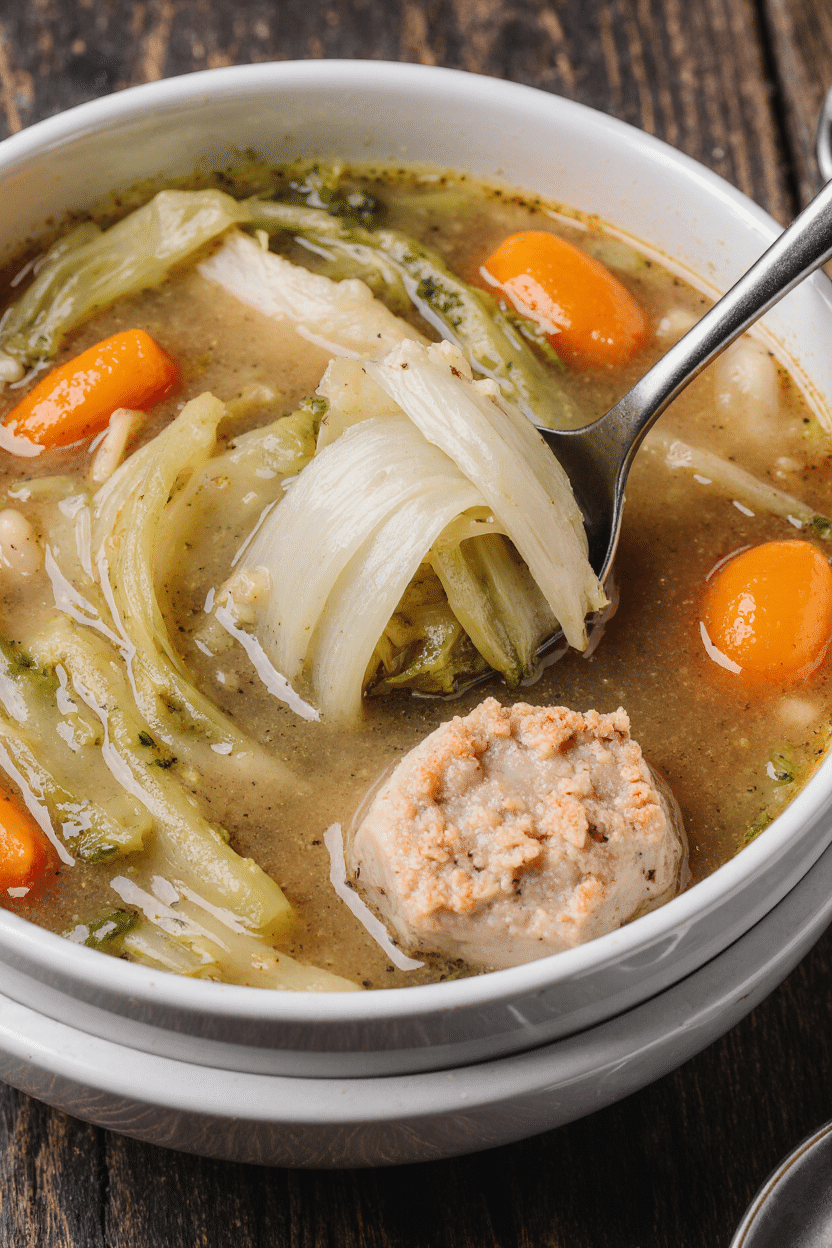This traditional Chinese Cabbage Soup is a soothing and nourishing Cantonese dish that uses just 5 humble ingredients. It’s deeply flavorful thanks to a homemade chicken and pork broth and is wonderfully light yet comforting. Ideal for family dinners, this economical soup stretches one vegetable to feed many and can be adapted with other seasonal produce or made vegetarian.
Full Recipe:
Ingredients:
-
6 L (25 cups) chicken and pork stock
-
½ napa cabbage (siu choy)
-
3 carrots
-
1 tsp salt (or to taste)
-
1 tbsp chicken bouillon powder
Directions:
-
Prep the Napa Cabbage:
-
Quarter the cabbage and remove the core. Separate the leaves and soak in salted cold water for a few minutes.
-
Rinse and repeat the soak 3 times, then let drip dry in a colander.
-
-
Prep the Carrots:
-
Peel and slice the carrots to about 0.5 cm (0.2″) thick. Diagonal cuts are optional.
-
-
Cook the Soup:
-
Bring stock to a boil in a large pot. Add carrots, cabbage, salt, and chicken bouillon.
-
Simmer on low-medium heat for 20 minutes, or until the vegetables are soft.
-
-
Serve:
-
Enjoy hot, either on its own or alongside rice and other main dishes.
-
Nutrients:
Per serving (approximate):
-
Calories: 285 kcal
-
Carbohydrates: 30g
-
Protein: 20g
-
Fat: 9g
-
Sodium: 1532mg
-
Fiber: 1g
-
Vitamin A: 3936 IU
-
Vitamin C: 4mg
-
Calcium: 42mg
-
Iron: 2mg
The Essence of Cantonese Cooking
Cantonese cuisine emphasizes freshness, balance, and natural flavor. Dishes are rarely spicy or heavily sauced, allowing the ingredients to speak for themselves. This soup is a beautiful representation of that ethos. It’s not flashy or complex, but deeply nourishing and quietly elegant. What makes it special is not extravagant ingredients, but care in preparation and respect for the broth—the heart of the dish. In many Cantonese households, soups like this are an essential part of dinner, consumed regularly to promote health, hydration, and digestive wellness.
The Power of a Good Broth
The foundation of this soup is a slow-simmered chicken and pork stock. This base is what infuses every bite with depth and warmth. Unlike store-bought versions that rely heavily on sodium and artificial flavoring, a homemade broth offers richness through time and technique. As the bones simmer, they release collagen, minerals, and natural umami that gives the soup its signature body. This depth allows the vegetables to shine while providing the warmth and satisfaction that turns a light soup into a fulfilling meal. Whether you use leftover bones or prepare the broth fresh, it’s worth the effort to craft a stock that carries the soul of the dish.
Napa Cabbage: A Versatile and Underrated Vegetable
Napa cabbage, also known as Chinese cabbage or siu choy in Cantonese, is one of the most economical and adaptable vegetables in Asian cooking. Its leaves are soft, tender, and slightly sweet, especially when simmered. The process of soaking and rinsing the cabbage thoroughly helps eliminate any bitterness and softens the texture, which is key to achieving the silkiness desired in the final soup. As the cabbage cooks, it soaks in the flavorful broth, almost melting into the soup while still retaining its structure. It’s no wonder this humble vegetable has long been a staple in Chinese kitchens, capable of stretching across multiple meals with very little waste.
Carrots for Natural Sweetness and Color
Carrots play a supporting yet essential role in the soup, adding natural sweetness and a vibrant orange hue that brightens the pot. When simmered, they soften to a buttery texture and release sugars that round out the savory elements of the broth. The simplicity of their inclusion underscores the overall minimalism of the dish—there’s no need for a complex medley of vegetables when a well-cooked carrot can contribute so much flavor and visual appeal. The sweetness also balances the saltiness of the broth, creating a harmonious, well-rounded taste.
Seasoning with Restraint and Intention
Unlike many Western soups that rely on herbs, garlic, or heavy cream for flavor, Chinese soups lean into subtlety. Here, the seasoning is kept minimal: just salt and a bit of chicken bouillon powder. The bouillon enhances the savoriness of the soup and provides a gentle lift without overpowering the natural essence of the vegetables and broth. The result is a clear, clean-tasting soup that doesn’t mask the ingredients but instead amplifies their best qualities. Adjusting the salt to taste allows flexibility for different dietary needs and palates, making it suitable for children, elders, and everyone in between.
An Economical Family Favorite
One of the best things about this soup is how far it stretches. A single head of napa cabbage and a few carrots can yield a generous pot of soup that feeds a large family, often with leftovers. It’s a brilliant example of how traditional cooking can be both frugal and flavorful. In many Chinese homes, this dish is served as part of a larger family meal, often accompanied by steamed rice and other modest sides. The soup acts as both a palate cleanser and a gentle main, particularly appreciated on cooler days or during times of illness and recovery.
Adapting with Seasonal Produce or Dietary Needs
While the classic version sticks to napa cabbage and carrots, this soup is easily adaptable. You can include daikon radish, corn, winter melon, or mushrooms depending on what’s available seasonally or what’s in your pantry. For a vegetarian version, substitute the chicken and pork broth with a clear vegetable stock and omit the bouillon or use a plant-based version. The adaptability of the recipe makes it accessible to a range of diets and allows home cooks to personalize it without deviating from its essence. It’s a base that invites creativity, yet it holds its own in the simplest form.
Serving Suggestions and Meal Pairings
This soup is often served as the first course of a traditional Chinese meal, but it can also stand alone as a light lunch or dinner, particularly when paired with rice or a small protein dish. For a fuller meal, it’s lovely alongside steamed fish, stir-fried greens, or even a simple egg omelet. Some families enjoy drinking the broth on its own before the rest of the meal, a common practice that warms the digestive system and signals the body to prepare for eating. Served hot, it brings comfort, warmth, and a sense of nourishment that’s hard to match.
Nutrition in Every Spoonful
Despite its simplicity, this soup is rich in nutrients. A single serving offers around 285 calories, with a well-balanced profile of 30 grams of carbohydrates, 20 grams of protein, and 9 grams of fat. Thanks to the broth, it also provides beneficial minerals and collagen, while the carrots add a solid dose of vitamin A. The sodium content is relatively high due to the bouillon, but can be adjusted to suit lower-sodium diets. With minimal sugar and moderate fiber, it fits well into a variety of dietary plans, offering hydration and satiety without heaviness.
Conclusion: Humble, Healing, and Timeless
Chinese Cabbage Soup is the kind of dish that doesn’t need to shout to be heard. It’s a quiet, humble recipe that speaks through warmth, nourishment, and tradition. Rooted in generations of home cooking, it proves that comfort doesn’t require complexity. Whether you’re seeking a gentle remedy during illness, a nourishing addition to a family dinner, or simply a bowl of something cozy and uncomplicated, this soup delivers. Its five simple ingredients come together to create a dish that feels both timeless and alive—nourishing not just the body, but also the spirit. In a world of noise and rush, it offers a moment of pause, a taste of home, and a reminder that the best meals are often the simplest.

